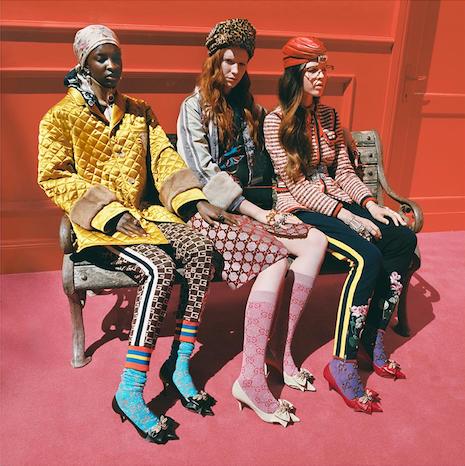A new report finds that a number of luxury fashion labels disclose little to no details about their supply chain, environmental and social policies, leaving room for more transparency in the industry.
Dior, Max Mara and Longchamp are among the brands that received low scores on Fashion Revolution’s Fashion Transparency Index, which analyzes publicly accessible information. As consumers desire more details about the origins of the products they buy, transparency is a key component to winning and keeping their business.
"Transparency has a different level of accountability than just policies and things that can be put on paper," said Lauren Fay, executive director of Fashion Revolution USA, New York. "If you’re sharing your information about what your workers are being paid, then you are illustrating that you are actually making the changes and doing the work to have everything be fair and ethical.
"I do think ultimately there will be a shift in public perception for people who aren’t sharing their information," she said. "It’s hard to equate that into specific impact, but from a PR perspective, the luxury brands that are sharing those good stories are benefiting."
The Fashion Transparency Index looks at 150 fashion brands with annual turnovers of at least $500 million. Fashion Revolution’s report assigns points to various forms of disclosure, with a total 250 points available.
Public information
No brand in the index scored above 60 percent, with the average across the sample at 21 percent. However, in general, Fashion Revolution has seen progress in brands’ self-reporting on their supply chains.
Among the 98 brands included in the report in both 2017 and 2018, transparency scores grew 5 percent.
Luxury brands have typically been less forthcoming about publicly sharing details such as suppliers, but Fashion Revolution sees that changing.
Gucci, Bottega Veneta, Saint Laurent, Burberry and Hugo Boss all raised their scores by more than 5 percent, outperforming the average. These brands all fell within the 31 percent to 40 percent range.

Hugo Boss grew its score by 11 percent over 2017. Image credit: Hugo Boss
In contrast, Longchamp, Max Mara, Barneys New York and Dior all scored 0 percent on the index, joining eight other brands. These brands were reached for comment.
Meanwhile, Dolce & Gabbana, Chanel, Marc Jacobs, Versace, Carolina Herrera and Ermenegildo Zegna received 5 percent or less.
Four in 10 brands within the index publish policies on equal pay, and less than half share what percentage of their executive teams are women.
Gucci was the only brand to earn all possible points for disclosure of its policies and commitments for topics such as human rights, animal welfare, carbon emissions, parental leave and equal pay.

Gucci discloses its policies and commitments. Image credit: Gucci
About half of brands share contact details to reach the team responsible for corporate social responsibility, allowing consumers to get in touch with questions or concerns.
While details about traceability have improved from last year, many brands still do not share supply chain information beyond their tier 1 factories where clothes are cut and sewn.
Not reporting this information does not mean that brands do not have policies and procedures in place, but it means that consumers cannot find out details about the companies they are buying from.
When brands do disclose their efforts and policies, Fashion Revolution points out that this information is often difficult to navigate through. Reports and documents are often buried on a site or are lengthy, making it a challenge for the average consumer to find out details about brands’ environmental and social actions.
Transparency trends
Consumers today demand more from the brands they engage with, especially when it comes to transparency.
As consumers increasingly desire to engage with brands that align with their personal values and in whom they can place significant trust, transparency is the best way for those consumers to understand exactly what a company is doing. Speaking at The New York Times’ International Luxury Conference Nov. 14, Antoine Arnault, CEO of Berluti, spoke about the specific challenges facing the luxury world in this area (see story).
Looking beyond corporate documents, luxury brands are finding ways to educate consumers about their supply chains.
Jeweler Tiffany & Co. enlightened consumers on how its diamonds make their way into its blue boxes by charting the stones' path from the time they are unearthed.
Tiffany's short film, "Journey of a Tiffany Diamond," travels with the gem stones as they undergo both careful refinement and an arduous selection process before being set into the brand's jewelry. Consumers are increasingly concerned that the businesses they support take responsibility for both people and the planet, making opening up operations in this manner a way to create additional appeal for a particular label (see story).
For brands that are looking to be more transparent with customers, a key factor is looking at their own operations.
"Really it’s about taking an honest assessment of what [brands] have and what they know," Ms. Fay said. "The key thing with transparency is just to go through all the tiers of their production and their supply chain...For them to do their own analysis of how transparent it really is and how much governance they really have over all their manufacturing.
"The larger the brand, the bigger of a challenge that is, so...it needs to be an initiative that’s embraced throughout the company," she said. "Change starts at the top but needs to be embraced by everyone, and there needs to be a change in how business is being done."
{"ct":"GkN1GO3Iwn\/AOhpt7uuS79\/u8cKMSvNO0h2QfXhWLd4TufmKQQCOOnXmr0X9OUDjZtaTxJz0+d82IW4rpV2B5Y\/r7GRgIvVKFOMa+gHzI2bw7EyNs6kJi2PALp2auOzcXOkBtP9AbrKWgE9fQvIJr7N4G6y9F7J6vzv73Hd2ZyXfFRb438MMLXB+cDqJiydjvWR4Wq7mZSi5pn5x5mDfDG6KlAHX38p3XpIzX3m3Zgnd+9Si32Tbu+BMig9vIfZFbhvazH9ojavcGflcIhncFxCNZbj+iKLBLNHn8R59Y7Ds3oXoP9p6DuJVq\/rhh9z0CGwIu8\/+RIV9I\/ViTlUZyVHLg71QFzhFuDRT2rSmiYwrT9fxdw7oHDc7+Qw0gbkt68fZTw6waqCmdluNZQOj3Gp842H\/JAGarG4QBzUAyGXgc5U45fk4WCKWyZefd7zvdCm1tjDEeZpCQxyyxZBFJ0gNpdi06M4X\/xg5PxPzCBXe9kZddVy1CCTe4l7ZfKxALwN7bNP+Wyp6qDQuiwHjMt0dL+ezYYPJ3gVH75TQksJ2fnumn1Y2Gaw1uHQ0feueBRKemIy1umsUlZfOyswdp+GA0Z4jF4Kl+gkM7Fk3ju+oBUPeK1yJIUethqbGmyVgLDmKzZk2M0dW4wVfBMSMuIwrW4SLPKfaBacdMDoYoqvQ2ZnVp4vQDdoiG3RNL\/u4BgWL6soZs+cu9KS7ECSHc4mB3cl9bqjRsN7FKGUr3FFDsG6coqhJPSB2MgpHR6721uiM0vGAy6yEh08OCktjNq+MZNePvcCjkuK7dwcsbSw0GCTFoeAq1PSu0aZiS+Zjp+T4g5KJT5gUqFJydR2ZEC0LwpF71kGUpbZBeBtZLmwKnq\/y5tcymmJv7ph5hxMJegzhR\/xt6nvmygxeRG4x7dUjkFM27oUJvZjdUeUWu0QncXmtPtPYq6ndS3DkhJ5ppmRCwmdoWfE0saNM5ktFA74qsdvpaWFBUw4wsGDYpSIbdaIyaRx5KSV3ftSaH3MaJm7xW9HnM3vyjLNSUU08y0HJ1PiBKL8gyRjBm0xGKIZ+f6a2fF8r9cW8UN8IV1SDWSojli44YktJtVbgT3GydGlwPlMTCjUJtI7xCNw0enap5hCRr3RvEBG3v61x2AjqTjz\/llXKHdOSmnbnzvTur9OsXFCj\/f60uirKdLLoygf90Z8r0h2OXYDaOIM4X5F9S34pVRuCuTpQWUqeY3IKCk9l6wbn72f3mOEwSTGKHldtFchbQaGveiF\/IuT\/009shk0KcB7MDPkRX2PqJvi\/Z0rv0tMWnASVmEMhFshx2vg33HqxIEntuHo1qfnsxi8zuiyBzEW0IEWQ1emv9zB+Am61r8LWeW0NkdVwyQou5z1eNJM4CUKHnSRs7s8HGq7h7XsdyVw7e0bjo9VQseUVMTlqWgtpoPb8oG8Wsjd9l+7FpRxXQJFdze8BurvVSw9eNhh8KmDNb2e95ExSpbtCMBgeUoQ9x4Xi861PMf+uhyK7hCB\/bOtbx0ZlX+HbzdONuWV857+36jPR5+TEyk62ToUAABL05l7MZcwhDttevbKd7YgCK4lBVVgoX3C3qP6S8ETECt2rkdiht1h0dr9VRgSs8+CvW89A573VhF+5Rd31B9aVI7H\/\/OiTWaW9HCudF9CTonRgMgoFmVpcGnm9XQaWPMWANaoqx97w4SZF09DbdJJ0NPQ1udu7FBHbEl58hJ+VXyAfN9v9bk6vSe3a3EtSM8NJLPq+Is\/iTpWJBobYK4dovlQycSGWwS7eFvDNEY3w4cw2VyYL3OX8F\/FXJ1ima1mMoUvXZI+xywzDeyEMPEBVFMb9O+747LrsWgjZ\/1iK0AnVoodvL8ZELHwEVBwKBzMxMsD2NU5VFcst3et4hEQijhbRzDjTwqTV1VKhqgBfKcNBNrGUsOtTkGWrMXkIS5yTyaQClxADeWpyu94bmlT466ewSBVAawfEBrvrqP\/zEoo87VbDvHrmL7JEMgx5UpDQG2i7hP3kOIU7Sr3vNE+GBGfCVVs\/TSdIWacTYdW7LIszDYNYuaNQDA3Fgpjh3bT9jpcZQqhYVE92HfgkkCXAfFmPQLcB87Orzb3lPYWUO9NDYlwJ1DxfrIWZXcHC618t3SClHlGXnSZYa26NDsyWgEatk5e0l58JhzalBiC2JhA1EgLIBZ\/P1xrOU5PfVoyvVLEALWWX2V5DUqIQOJiTJ5RQqcbU212XUed8uiiV28j0iMFM1ZEx5MbpbIR3cfhgyPCSFLtKB2WWAGEbqJ1skik1E8JEfuQivaEGmHfOWqDJYSp3lg6I2kUbNp+4EK5zx+ok3wS4rNRF+rNIOz3yL\/FrnUVMWKKmicMZ9m7cwKCqDG1MJiiphc62w0wM3qd0FgrnnJdGeNMZ4cY7egh88gh3HqOoN6sy\/7u3vwwYmRo2yUhM6570L+Mcri8bRtjLzTdv+UuH3cbCQLTsbYSv3ffvFG2tuFu8DwDX1bxk7Vp1OMnw\/GZOAPZ1tz4OHKDlhvRaxRAHj9ZxqnoSY16pyDw8cTIyqWLEovfcCWGy0dW8PKlFTaDdSDcBTF3IKAc4t35HSgp9k0Hyul9aCHI17WJYE02B\/1+dM0PK8kOv\/sEV+tRxBeKwUMwykCIVyOkbSrp6RDvRYKNRIwBZEIqGQefG1KHfqqG5x3DdAhwgEwGLaEPwscEYtp3dv77SnQvLQOZPgQrHuNv0NjlNkdvw3uAzDBcWJtAs\/O+W8Loi7+WFGlStKnESRhOuEwhKMDQWqKMUcv6kKO3L6xHS\/F0A7jK+UUvCCHytt0bQVneBX8dAkcbYFbCRMHdlS0GlQJteKmiQCX0ANdoh\/719y7Hex0b89rj\/5SMWnaRQ6pIkVHrwIyzRa+JDcKIKCcZzk0jwoPk0L3ATKi6F6N3+9BR71pkj3TVL6QU8zENveegMyp33hVHnneOKgOVU6SMsNtLrV+l0yGkn4CXZm4ixKk5i5Knwaiw7c+IFomH6kx0MN3fov90\/egKg\/sj1jOylRv2JkHOF\/1zAaQWN8LzgnTeJEjHOYTx4LFTaj\/hX09T1LsjZMech9i5AbE1syFHzchTNReW36loQ7rUKxPo1jELVIMfOlBUpUiLJ7T6i7emgCrcw4TvRndyzWL\/3VVk3bd3C8YeUPMXFmPjbC8fCjAM8+A3Dk3Mh7gl0Bm6f2yIO4R5uXNdFE\/OZ9bcl3wFCJ8kVDK9y0LMY5nnN5RIKZSkjdvRrMcU5HCaleyQyVB7ycHIuwkbWrwZ9+lyctA\/hn0Fv8whM3SHpJGz8vetGWhNe\/0KFmquvZuGmw5Wy4IyiGYaCgVFX2t4NJSRPc4+5672hd2WBpaDHbXYNETTyw5esndEQY5FSwXVWPUQw4dvFWehyIoFXvS9l3N6x+5RutpnpY7BZh90Asz1OMHOQPR8ScvVY\/zoB61jaqLXOmZtCtEUC8bNBxYj3u3aAyT3IjMFXNqpwL0PcewFnTexSx3La5tnHVYCDTWWa7BOgCCuLwOhdsQGLkjc6wLVYwV4y5q6QWBreVw64sgTX19AbLUMTRXv+vctItTQAhmtWp\/+\/y6790Qcad8J+WHNoSbN6oU3rrn8PbBKNL2Er4MCJfjvVz\/buDYwEfn5S8E211HZri4o00QjJW2TfKVVNQJUOxuf0tCRlvQRTc+Iix4q5kzXHd1NQOsVIbgsDBzI9xvQSH+gYterTmvkK4HELKm6rWtWxH2rm9PwP49gYrN+SRzMOggPA+5gUVkUtuNwTbr39AQpYZa\/eTRNUS+O4F2FFlhSbOg5csEfMFYr4kpvcWhBWmEWbvwcvAOR3mHGKXI3YRFU8Dc4v4usJp2mhCQYyHaiHdbzOI6QPfEEDiSBh2I8qlqh3nsfaQysPp5hzRuQRQxZiq148Zsrr8GHw3TtWALJKFi8NlB4lNHNeYe+H3dubxp4NkiIGcT\/YYesbYf+pFoMzwlK0ZJAUZAPsR0Xa4t3J0v2cgkcXvVHp1Y0MSk1hw+FgnEE5WDHBGkmuT39bRyxqGgjm5WsSYaaazvnW9l2\/mInEarTAhAxRmX3mVbiI6AFf9L1ZfvreJQb+4wsCn5M\/EaT5npV4iY88ADuLPekkU0+BNLkyeQV67+\/AK\/YmwcPjtAghucEjj3RotiIkZEZ91wXJgtI5wunQVpyJmty11V9BjJwb0Igw096oGPT6ZiWCQUtoO3wkptqQNyTl6BE49YDnZci0akcTTbVVouYk+MMoBfnLxWg8EDL2MrO+IMP8yxzf7S\/Ay1labG9UEfPKXEvdxgoXp+RLDZtP4jQTOG9Y+se+IqDC4xq4SSYIQxEHKoz+j74IgCr8t9t2QRlk3xv+NX9trFy\/M\/gsqoUDk1srBTLeFoZhW5itU+3+qSeNw0ioziZGSU+0QtgQSWynIhpbeV6HcYwAl8GcU5p6xi93kL8cE7jN8iMSIM48vEdHuta1IBC4AdhkkszLwjIgBuokZyJUk0rafRTCGQfpHY5jkqcJua0zxwfGDnfSyOAoYH5iYmMwl6AxpGIXLXVumD\/ogXEgisk4My27PJ9fImRMLJ2Nu+JKUdc\/fGggttiIrg3QX1z3gjy33+i4HmW15FsxQPqkpNcf1DBBK7HC08qjSeVC7MERJTkRHmL2RhADSWB00j35eEvZrq70CtjQWHUE9a1KfpCBqPEniTEcG6DM\/GzmimBVhAFG6Lzf86Klae92yx0\/eg++V8KW+LdR8xtcpGSN7dCtxMH9KupW6bNj4rb122AF1DGGj\/wAck3slCroLjq4JKRn2aLtdDvO8LE36+iQI5X++qz0mdv5vyERLJt7iTrSk4Ui5Qweo+yW1j\/ZTUGeq6uv1S9PuU7uDtywpiilrtE1\/qLYnRvoCeSiaoq1zB9YRZxK1LREUTxokz6AU8gYct1kTSRdAoP5xUY+MbZITqgGbuVMzdDKXZoZIaZE1P0BezFiFiXfVI6zSyHpvtmDMd2dqtJWN7svPyZDvYf0Ekr4\/f7B3Dr3+5AjqRwVzAL1oyK2Nb3iIOIjwJAOl2mh0GtWxk+aw4QH9Ze66YQBlY\/WGmGJDPvUYp5m\/03AYMBDyINiYTmt4x+QJXZO7OCrnBDMjJl\/vM0pyzZFvsXmaabS\/kY5hf6dPYlufSxz8f1fc5AoyjrPlEVVi4UdHawzP4kY4VQFQZTmkApMiLL2NUbo5f3WnlYIOIwZvKpJ3+VO2ATo1e\/Lk9zn6YKa0S4zhvwLPAp4+ool5KgPy4TPQvNMBnAuD09M3wIeWcdCBKBX+v+TUrHpfaanHoNvHaG+NclBT6L2isQ9rlboNE+J\/GNtG\/imjnYB4HbGpZPbtOEAUkbmx\/D7kls6asRALTYYg\/OPTRzOyGmbePFUFuC8jXI\/fkzMFWjjGsKS12mji8rin58ViL6WXNeFVMMnkFwfzkaIbs+8ZRsU4ehCk28JVjpJwt3mX9pcGQNcy6E14D+t4EN8IK1L3rk6JvMPb4DsPEsTFEE47Fb7x\/Z0OVFXQS\/lq+hiNQnDtyH8tRSsphidtO9mrpLYuequV3K09t5TJ+G04M2k3PglhmkDllmLNFcHEu6pqf3RHGWh2ivHDFpx3daR1J3ijLtSlypqmjTjF\/WNNFFxrHco0AOBjR3Sq+wOQAXtB8QgeLA5EbKNmdbMgSaFK4Uz4Rmwc5j5wsr2f0TcIWltQ+mr7az1skWvg59mI05QNBXhbtrwZ\/5ThWQ10Ceahu2PwypeHdlWOVtARyn8v9X6thBKNTrSvUm\/245Rm6z0HSUI1YdpJVxg6iqgbh209zqxCdfhKQdVtNqjVr+szzKNoKQshIlKE\/MWl92+6jgcUMf79ygdcbCexBWfAP47pZcP0thqtBfclJj0PI6tfVZzBlcpiaZbS8tS1R20mGOnjX++bsILxe252RuLIECODicg0RD2AQkmoEEBj4N\/Wjb28LgBtDd8HrIUJdUUnumCvouFj6wCabZapIo2OSOsBnz07Jc4F5h+Gv+sWG7dysWGzZcvLFgl9xS10dGJNsKKhkRtHcaAYsL5b5deHE\/Xi\/gY\/nMvycz0Q8QmCxaF8CA+1RmRGtgJnagzzkO4h6291A9PV7rDqGFVKC2lW7+9\/jzAN1j\/7un5A5bDRmu33rU+i6ajQqDWVL4i7DRD1BbO4ILw7VkKWzDugHhzrEqNHVrLYBnnSSNhO5RCVqrmpkEWOQHk9BJbpT5O0P0+PE3ZAPeXfgEkO61gN7Tea92Zbgb4\/YpK1ZaFFA61Ibn12F89tVkPg5EpvovMcFa0DTCl7k+Kn8yIYTVyVMNw6SSpF\/z\/zSN\/fJZA8iB2iIol+thZ9VtK4Ug4BEf6yk0y8DaG4HP1ybcYdscrBtaCmtpVZKilpvvI9dEv\/JQDnI5IriNM4BlrXyhdSaZ+g9O\/L6haWqp4QrfN393A4ea2phTR\/Hf+oxfwPhGOfODh4VVFg3YU818xpstgt5K5hS5a+Xbes+82C0Ab6wKgEaFK97tpsM12AwPoPa\/JZ0PcR\/PNUgXiUkDvBaMBQp7YVI\/bl1HMz6Lk8bArf3UnUDk9OWR\/93xCZZyTU\/kFoD4Lw3WPHe2RyHBGHzwegmEciW6txq3k153JCGlIudCd\/dtvDmXpDPxmibGl4jl5iWJVWbG11lB954+1hwCMvBP6W9A6S0BnGp+QJ+IH2++tAKV8UmwxuZ4Zqn99fiCPbCd+Qsx+E\/XK8bNh6+\/8TAo945a\/dRn6L09d\/cZAFyKOxyyLp1kFPFiUpVHaw\/v7ALAtMKaAYfpwmXyGLaa05ge5OHV5O2TEvz3KB8DgdcE\/NBRI3EW9RsqR1fSjVdG+lES3UMXWP8ScsFn49I86C6O6FPdIJEOreCVe\/XJ3n+5JzHd3+DbC\/HSJC8ZnpFGKydQ+YARW3JsWVd7mPunRx7CVVoetyVykCYVhFooFhnWB7+KbQbzAiGiCFX1a\/zOt3Bdhp5v1zxDwOtSfztAbjxOnN5ZSt\/Rngyd4Y9\/kvZu8uKMa+9HB\/BBQC2h0j1jFPNpJ+B9E2AQ5hz\/RVI+5rfUyF3ReoJMLvYrgig7KQ0vJy9NW7A2UBW889Ah9bdkQ27VLHG2R7c4nhMoiSnbcvZwOSeewOjKdE6f\/C8716rZQ+t4bKKDzbwU5Psrn\/vZZItpI4dg9EULkcM\/H9ruvDXTZwpjPKzZA+URWkrhmfHa+JMYgUj5TmIrGSqVF5oPN4Yr4Y3w50Gd6kfX\/n8i8q+LEpG1MSc71dU2q4q9\/47bbSj0KFr5DgDThWEtgSCAMVJ8hx6RNgZw49D+m\/oyy+dsDfZfNy3mgUi6klXqmxwUeDOHld82b0bYoI2PwehqoAuX1Cva3PavrhXGSbx4LH0w7IJLf+D3BJcSVQQyi3pG+lo\/iBsPvgUVr+g7TcLriFWvpEEuHnvypp5kkXIXdpJOc8lbSn0ycxeSTp6J2U7taykIyxOO66mtt1tgAM1RcbhPF0uY3AwZutMyK8q7wfFOExUYC0zDINjKwZzGhvZOPrFH\/L06Skxs\/vvIV\/DHhVV8UzwMXzXMNoGGmaZj\/CJ+uy0t5BJdnF\/PEuaDrDIJ8prLzpw0o1E6bpNZYiSGo5BlCBGPksFJCJ+OqA7B3urULb6SQFh+HJIx\/Es9NsWCaP2th2SfLzpUXv7Mbpsbhmtl7HUSI\/NZC2mZDHQjlaQk5b3cV9dB9UiLw8w8f\/JeoQ3Yf+YAlZ8t2Ox665jPO1PZnUVJa0giVmlLYmcvNcD9PfZ1YIi2W3ln4YOlOIOL1uIXljzxnkwD6jvY9wCWW1qgj+sd86SItdbmMy3+lRA7XT97meGKuVsa2c8FEN6kUF9rM45PNF2bjTsJvlrJEW3KugSx8HFWDfW7oJeRHLNSdD7NJxXdTEqQAc3G7X9Po1qucTOXC5CIKlK3PKDAC3bcQqe6VvHnfQegv\/35CKqD2Gdgaj0t1utVgO0+kH+ECS5aYRaPYek5NgdPWz8IBpjUGNx0A7Hvl6mTfIshCD887+2CAxwCWlhPzRqFM6H3b4mj7f4wQUKw0mKnt3QzPdW4PLEbaNCQbsfMBL0MgOGsScdmag4W+I5GZG\/nwOAyFMCZtmGMhqd4KblhKtsC8WOyKeVwrZxg+kbu+fAUDS+PRupiGKd6cSLAyGl\/Bs22\/+EfXroLIEThCAYBxQoYC\/DENSNmamuWruJVMnOf7jSXamokWflYsfw0ufBXkaA4BeKQIDpDuMvcmV\/KueSwzm8SNxPwvsfdY9RWLv1Yo\/HotnHYiVRiqnyCyq2Hx5P3jwRprm\/INSE+jKHI71lMZcks1alxFPPmmBcUhdyRHl3WDt5aPvpf9umnLPTgtoHpdRpXZgs9+k7qzXMqm8rd8vxZLrB7qRPKw8QyVkCcC\/HHi77Wmv7IJ83TYs7dv3qOWGPlBHoK7tQ94dylDLBfQ2hN+SqkRPI9iIlBPTWMhv3EAB61mKn5WjPg3sp82zJi+pzvwxvE7d2IIxQkr58NNee+rDIvWHrXfIp8iu4JuFSzKAj6TRN2p1JutloLOsGfIDJEb09XQztTT\/TMBxkNQAsaZzdPmBBXNnWF5U9x2mkltnJmFD9A6ctmSz9awqHTYvq9hc9jmBUCe5uAa\/0UOOuHSqoVLTvUHKZpglsRZTNxS44lt3FfMwkQKNhP4j4mhCLI07dOYaNh1cpvFHcL95Lcji2NASixhsVY3e9NsKJEYIyOuzL+u9EeA1aVNV3RWAp\/nk5DE6awWcnn4sTJfCXGgVfjferT3Ctim3gSIxKZyDy187wcTk8scQK9pEqdFhjFITuly78BGG9ocyrh8o4NPV1eSN33C9XeCe1um0FUuNw8BpCcRRTG2Pcc6Na++oDFQs3XjnPohcuJep436YxQ8KBuwnYeUH6Mr51xrMaNDNt\/+mp0Fqs\/dyarxEon5Eh7Ve5BvLZDv2pQXUCEXcuUR7vbDeY75VaAh+eOk7F1Cse3yb0\/WrkjtTY\/TC7JR0KF7CXPbli3SLoNnjZS0KMfnd0aDpDdDavEjXyGBjNZVCxcmOaLmKoYwi6U85YjsCGoqCtS6qxFFcAg19vCimuljH2AOvXkJN9kZ0geWJ8r6\/8KM8YOYVBYAqHBYVIX8xdmNjXHiVXPjZP8FBuVT\/vaFCqjluGzWAWHS\/CurFx4eUUZWI655n0p8nKAxzi5YDt9Tz4n+UXdki6jyYb\/R1hbT5\/KPNg04g7+HKJ7k7tgrZVV\/Lww9J7Hr5wtfHRYgxS+BH9uJ9Na99wYs4YsYDu9Hqv4r6Hko3KqsC1f3okg\/Ley+4ZG1OlShztMF5ZxlR8tKk+OFeKaJJXb2Dl6lqSWF+lg\/rnrOj+GZ06SjNkDwqNLXKbIlia0hP7v6RvWcc\/Aad3sOEv3KjQjaAAhJyuzSRiKlfnmXcmB0oUntTftS\/\/xR7xOf\/qm4iKpM1uP+FxbKjbLhX7iNqMcDQr6FihdIPCQ8D5Gf1cQR8iAeJneSGws3dBnfAwJDYvZXeAmS21yMjcojJqP5ERpjklxwo48BbzV0Q7nVHeEnyPFD5ep80lao8b+OH8DPvv3dG5CQsOj6fgnGnD3qM76UynfSjgOqoKLkd1Pbd9YXUCNHgz2fv31O74GRx3a+Apzl4dRtqG3cZ8vSwg8UzV5uZVD+WvaHWZMD0d000Vo7aoIvkULCsfaBhg==","iv":"fbd40ba0bcff1799de47b27776d24f6d","s":"5d2aea67c436704d"}

 Fashion brands are making progress towards transparency. Image credit: Dior
Fashion brands are making progress towards transparency. Image credit: Dior